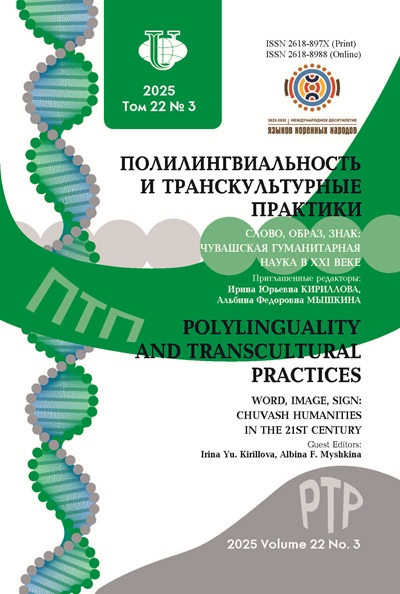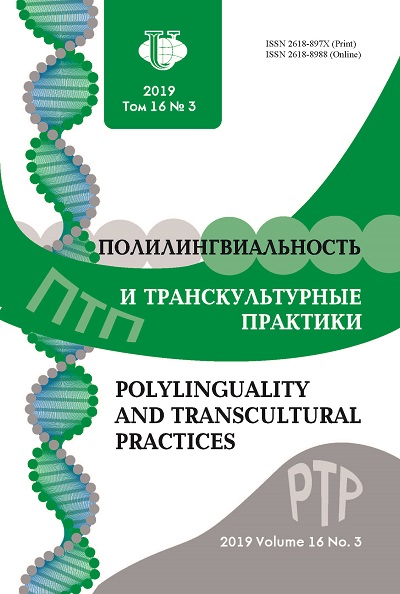Том 16, № 3 (2019)
- Год: 2019
- Статей: 14
- URL: https://journals.rudn.ru/polylinguality/issue/view/1216
- DOI: https://doi.org/10.22363/2618-897X-2019-16-3
Весь выпуск
К читателям
К читателям
 306-309
306-309


Языковое сознание
Исследование влияния изображения и вербального текста на восприятие креолизованного текста (экспериментальное исследование)
Аннотация
Статья посвящена анализу проблемы влияния вербальной и невербальной частей креолизованного текста на его смысловое восприятие, специфика которого обусловлена тем, что невербальная часть (изображение) идентифицируется при помощи зрительных образов воспоминания, а вербальная часть (текст) - при помощи вербальных моделей, отображающих также неязыковые образы сознания. Для анализа смыслового восприятия креолизованного текста использовался метод семантического дифференциала Ч. Осгуда, который позволяет фиксировать результаты смыслового восприятия, осуществляемого как при помощи образов сознания, транслируемых генетически (образы цвета), так и формируемых при восприятии своей культуры. Примененный метод семантического дифференциала дает возможность вскрывать не только денотативные, но и аксиологические характеристики содержания креолизованного текста. Представление результатов в виде семантических пространств позволяет выявить закономерности влияния изображения и текста на понимание креолизованного текста.
 310-321
310-321


Языковые контакты
Особенности современного билингвизма и его кризиса (на примере национальных языков КБР)
Аннотация
В статье рассматривается ситуация билингвизма в Кабардино-Балкарской Республике, которая оказывается органически вписанной в общемировой глобальный контекст. Авторы рассматривают отдельные наиболее репрезентативные критерии, которые свидетельствуют об объективном состоянии государственных языков КБР - русского, кабардинского, балкарского. Приводится классификация «групп риска» ЮНЕСКО, а также факты, иллюстрирующие кризис родных языков коренных народов республики. Кроме коммуникативной, рассматриваются важнейшие функции языка, которые позволяют языку выступать в том числе в качестве основы, заключающей философские концепты.
 322-329
322-329


Истоки современного адыгского (северокавказского) литературного билингвизма (К 225-летию со дня рождения Шоры Ногмова)
Аннотация
В статье рассматриваются аспекты взаимодействия деятельности адыгских просветителей с представителями русской культуры первой половины ХIХ века. Авторы впервые предприняли попытку изучения «Истории адыхейского народа» Ш. Ногмова в рамках карамзинской идеологии «Истории государства Российского». В исследовании также изучается вопрос многовековой взаимообусловленности русской и северокавказской культур в контексте актуализации проблем современного билингвизма в условиях современной глобализации.
 330-336
330-336


Художественное измерение
Литературный транслингвизм: что и почему?
Аннотация
Статья посвящена всестороннему осмыслению теории транслингвизма. Автор рассуждает о сущности предложенного им термина в контексте мировой литературы, приводя многочисленные примеры транслингвального воображаемого. На материале творчества таких писателей, как Джозеф Конрад, Владимир Набоков и другие, в статье показано, как срабатывает механизм интеркультурного и транслингвального взаимодействия языковых и внеязыковых элементов в каждом индивидуальном случае. Теория транслингвизма обогатила цикл гуманитарных наук (от лингвистики до культурологи, от литературоведения до философии) новой востребованной эпистемой, которой редколлегия с радостью делится с нашими читателями.
 337-346
337-346


Сравнительный анализ лингвостилистических особенностей творчества писателей-транслингвов
Аннотация
Данное исследование выполнено в русле теории языковых контактов, теории межкультурной коммуникации, лингвистики текста и лингвоконтактологии. Объектом исследования является художественный транслингвизм. Предметом исследования являются лингвокреативные характеристики транслингвального художественного текста. Материалом исследования послужили произведения англоязычных китайских и русских авторов (Olga Grushin, Irina Reyn, Lara Vapnyar, Anya Ulinich, Gish Jen, Ha Jin, Amy Tan, Jade Snow Wong, Frank Chin и др.). В рамках исследования были выявлены сходства и различия в выражении лингвокреативности в художественном творчестве писателей, принадлежащих к неродственным лингвокультурам. Палитра средств описания родной культуры, используемых авторами-транслингвами, очень разнообразна: заимствования, кодовое смешение и переключение, прецедентные тексты родной литературы, контаминированная речь, использование лексем английского языка для передачи значимых для родной культуры событий (путем придания им культурно-специфичного значения).
 347-357
347-357


Карачаево-балкарская литература и проблемы этнической идентичности
Аннотация
В современный период проблемы билингвизма в литературно-художественном (литературоведческом) аспекте связаны как с изучением речевых характеристик персонажей в произведениях, так и с анализом художественной литературы, созданной писателями-билингвами и воспринимаемой билингвальными социумами. В формировании и развитии литературно-художественной школы на территории Северного Кавказа большое значение имело распространение и изучение арабского и русского языков. В статье прослеживается динамика развития билингвизма в художественной литературе народов Северного Кавказа (ХIХ - нач. ХХI в.). Используется культурологический подход к анализу билингвизма как важного феномена, отражающего ментальные, этнокультурные и общечеловеческие духовные ценности.
 358-365
358-365


Стереотипы речи как индикаторы этнической принадлежности к русскоязычным писателям Казахстана
Аннотация
Работа посвящена исследованию этнического стереотипа в художественной литературе русскоязычных писателей Казахстана, в частности стереотипа речи. Статья содержит краткий обзор научных источников по данной проблеме. Задачей исследования было выяснить, как стереотипная схема мышления представлена в речи автора или через этническое сознание и мировоззрение в речи персонажей. В художественной литературе были описаны следующие основные черты стереотипа в речи русскоязычной (казахской по национальности) языковой идентичности двуязычного писателя: наличие определенной структуры; использование пословиц, поговорок, метафор в словах и словосочетаниях, сравнения.
 366-374
366-374


Постоянны ли константы?
Аннотация
Границы художественного произведения меняют восприятие, казалось бы, самых незыблемых физических законов. На примере произведений писателей начала - конца ХХ века, создававших образцы так называемой пограничной литературы (Н.Л. Лейдерман), мы рассмотрим этнокультурную составляющую некоторых физических категорий и их роль в создании образа «своего» и «чужого» национального мира в рамках русскоязычной литературы. В качестве «противовеса» друг другу использованы образы мира кочевников-степняков и оседлых славян.
 375-397
375-397


За какие произведения присуждают Нобелевскую премию, или художественное измерение романа Кадзуо Исигуро «Не отпускай меня»
Аннотация
В 2017 году британскому писателю японского происхождения Кадзуо Исигуро была присуждена Нобелевская премия по литературе за антиутопический роман «Не отпускай меня». Авторы статьи в рамках онтологической поэтики рассматривают эстетические достоинства произведения, обращая пристальное внимание на степень его актуальности, специфику художественного конфликта, преимущества женского нарратива, а также разветвленную систему экспрессивных средств. Итоговым результатом анализа является высокая оценка художественного мастерства писателя, способного сочетать широту философского мировоззрения с тонкой работой литературного стилиста.
 398-405
398-405


Теория и практика перевода
“What is Your Good Name?”: некоторые аспекты перевода мультикультурных текстов
Аннотация
Настоящая статья посвящена выявлению особенностей речевого этикета в индийском варианте английского языка и отдельных аспектов его перевода на русский язык. Актуальность темы исследования объясняется все большим распространением парадигмы World Englishes. Лексические особенности индийского варианта английского языка проявляются в использовании формул речевого этикета, в частности в индианизации форм вежливости, обусловленной влиянием индийских языковых моделей на английский язык. Одной из наиболее распространенных речеэтикетных форм в речи носителей индо-английского варианта является вежливый вопрос “What is your good name?”, обслуживающий этикетную ситуацию знакомства. Цель настоящей статьи состоит в том, чтобы проанализировать этимологию и найти причины использования данной формы вежливости носителями индийского варианта, а также показать важную роль подобного анализа в преодолении переводческих трудностей.
 406-414
406-414


Некоторые принципы художественного перевода с позиции билингвальной личности Бахыта Каирбекова
Аннотация
Статья посвящена рассмотрению вопросов художественного перевода с казахского языка на русский. В центре исследовательской работы - творчество русскоязычного поэта, профессионального переводчика с казахского языка на русский, исследователя, режиссера Бахыта Каирбекова. В настоящей статье на примере стихов казахского поэта, просветителя и философа Абая Кунанбаева рассматриваются некоторые переводческие стратегии Бахыта Каирбекова. Автор ставит перед собой цель выявить переводческие принципы Бахыта Каирбекова при передаче творчества Абая на русский язык. В результате сопоставительного анализа работ Б. Каирбекова с работами переводчиков А. Гатова и Л. Руст мы приходим к выводу, что переводы стихотворений «Не падай духом - нет печали вечной...» и «Мне торканье часов - звук не пустой...», выполненные Б. Каирбековым, наиболее близки к текстам-первоисточникам.
 415-423
415-423


Билингвальное образование
Изучение современного иврита в России: многообразие целей и пути их достижения
Аннотация
Анализируются проблемы изучения современного иврита в Российской Федерации. В частности, отмечается, что иврит - язык, изучение которого еще совсем недавно было запрещено или, по крайней мере, весьма ограничено, в настоящее время изучается на всех образовательных уровнях и в самых разнообразных форматах. Иврит преподают на различных языковых курсах, в том числе при разных еврейских организациях, а в последние годы появляется все больше курсов и частных групп, предлагающих пользующуюся все большим спросом услугу изучения иврита в онлайн-формате. В целом, за последние 30 лет в России создана собственная школа преподавания иврита, осуществляется активная научная деятельность, проводятся международные конференции, издается собственный журнал.
 424-442
424-442


Memento
Гачев ушел, но остался с нами
 443-451
443-451















